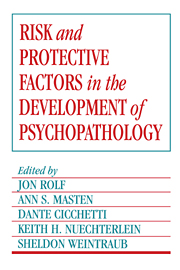Book contents
- Frontmatter
- Contents
- List of contributors
- Preface
- Part I Introduction: Historical and theoretical roots of developmental psychopathology
- Part II Contributions of the high-risk child paradigm: continuities and changes in adaptation during development
- Part III Competence under adversity: individual and family differences in resilience
- Part IV The challenge of adolescence for developmental psychopathology
- 14 The development of psychopathology in adolescence
- 15 Depressive symptoms in late adolescence: a longitudinal perspective on personality antecedents
- 16 Vulnerability and resilience in the age of eating disorders: risk and protective factors for bulimia nervosa
- 17 Protected or vulnerable: the challenges of AIDS to developmental psychopathology
- Part V Factors in the development of schizophrenia and other severe psychopathology in late adolescence and adulthood
- A closing note: Reflections on the future
- Author index
- Subject index
16 - Vulnerability and resilience in the age of eating disorders: risk and protective factors for bulimia nervosa
Published online by Cambridge University Press: 06 August 2010
- Frontmatter
- Contents
- List of contributors
- Preface
- Part I Introduction: Historical and theoretical roots of developmental psychopathology
- Part II Contributions of the high-risk child paradigm: continuities and changes in adaptation during development
- Part III Competence under adversity: individual and family differences in resilience
- Part IV The challenge of adolescence for developmental psychopathology
- 14 The development of psychopathology in adolescence
- 15 Depressive symptoms in late adolescence: a longitudinal perspective on personality antecedents
- 16 Vulnerability and resilience in the age of eating disorders: risk and protective factors for bulimia nervosa
- 17 Protected or vulnerable: the challenges of AIDS to developmental psychopathology
- Part V Factors in the development of schizophrenia and other severe psychopathology in late adolescence and adulthood
- A closing note: Reflections on the future
- Author index
- Subject index
Summary
Over the past two decades, bulimia nervosa has emerged as a significant mental health problem. The syndrome of bulimia nervosa is characterized by recurrent episodes of binge eating, during which the individual experiences a lack of control, followed by regular engagement in self-induced vomiting, laxative use, or severely restrictive dieting. Today, as a female passes through adolescence and enters adulthood, she is at considerable risk for developing bulimia nervosa (Striegel-Moore, Silberstein, & Rodin, 1986b). The pioneering work of Garmezy on risk and protective factors in the development of psychopathology (Garmezy, 1974, 1976, 1981; Garmezy & Streitman, 1974) has stimulated us to consider further in this chapter those factors that serve a risk or protective function in the development of bulimia nervosa. Following Garmezy's ground-breaking work on schizophrenia, we suggest that research on bulimia nervosa must encompass not only the study of bulimic individuals but also the study of women who appear resistant to the disorder.
In this chapter we consider what is known about the risk and protective factors for bulimia nervosa.1 The information is incomplete and often tentative. Research on protective factors, in particular, has been virtually nonexistent in the study of eating disorders. We propose that they merit empirical study in the important tradition of theory and research begun by Garmezy and his students and colleagues (Garmezy, 1984, 1985a).
- Type
- Chapter
- Information
- Publisher: Cambridge University PressPrint publication year: 1990
- 13
- Cited by

